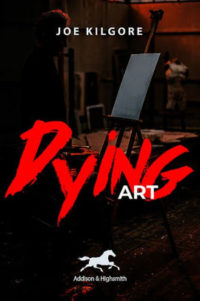Title: Dying Art
Author: Joe Kilgore
Publisher: Addison & Highsmith
ISBN: 978-1592110919
Genre: Thriller
Pages: 260
Review by: Anita Lock
Hollywood Book Review
 Artwork turns macabre in more ways than one in Dying Art, Joe Kilgore’s latest in the Brig Ellis Saga.
Artwork turns macabre in more ways than one in Dying Art, Joe Kilgore’s latest in the Brig Ellis Saga.
Brig Ellis hasn’t seen nor heard of Lela Mangas in years, yet the war veteran turned freelance investigator doesn’t waste time taking a plane from San Diego to Texas when his high school girlfriend requests his help. His nearly-hijacked flight, thanks to his stealth, opens an opportunity for him to meet and leave his info with Rebecca, a drop-dead gorgeous flight attendant. The encounter is short-lived (for now) when he meets up with Lela, another breath-taking beauty. Any affections remaining toward her get thrown to the back burner because he knows she’s married. Plus, the reason for his visit is to be a bodyguard for her husband, Tilton.
Tilton is a painter who uses human ashes as his medium in the production of his oil paintings. While affluent connoisseurs marvel at his unconventional craft, others consider his work nothing less than an abysmal attack on humanity, the latter exemplified by a religious zealot and soon-to-be Tilton nemesis, Reverend Barry Tompkins. But during three private art exhibitions that turn deadly, Ellis finds he has more on his investigative plate when the list of culprits grows and becomes convoluted. Whether or not he can target the perpetrators before another impending disaster remains to be seen.
Author Joe Kilgore grabs his readers’ attention from the get-go with an airplane scene, one that could easily be interpreted as an ominous narrative foreshadowing. No doubt, “all things threatening” unfold in unpredictable ways. What the opening scene provides is not only a glimpse into Ellis’s skill but his love life, and what good mystery isn’t complete with a bit of romance to lighten the story? While that theme runs secondary to Ellis’s investigation, Kilgore makes sure the amorous underpinnings and the possible reignition of Ellis and Lela’s relationship flow side-by-side with the building tension behind the calamitous art exhibitions.
In a nutshell, Kilgore’s third-person narrative could easily be divided into a few settings: Ellis’s thoughts (romantic feelings, war experiences, and the inner-workings of the investigation), the art exhibitions, and romance. But one would be foolhardy into thinking that Kilgore’s story will unfold into one anticipatory scene after another because it doesn’t. Kilgore’s sure and steadfast writing style ensures readers that plenty of skepticism will abound as he includes a small but very elusive cast amid ponderings of ethics (or lack thereof) behind Tilton’s art.
Kilgore also employs his keen sense for details in various surroundings (rooms, structural designs of buildings, roads, and landscape) in Texas (i.e., Houston, Marfa), the heart of Chicago, Cuba (Havana), and San Diego (Prado, Balboa Park). The descriptions are so vivid that one could effortlessly mentally transport to those settings.
Dying Art is a book that I will not forget, and anyone who is willing to dig into their darkness a little bit will be sure to enjoy it just as much as I did. A never-ending clueless “game of Clue,” Dying Art will keep mystery buffs transfixed to the very end. Kilgore writes with a chilling prose that could easily leave any reader on the edge of their seats.

